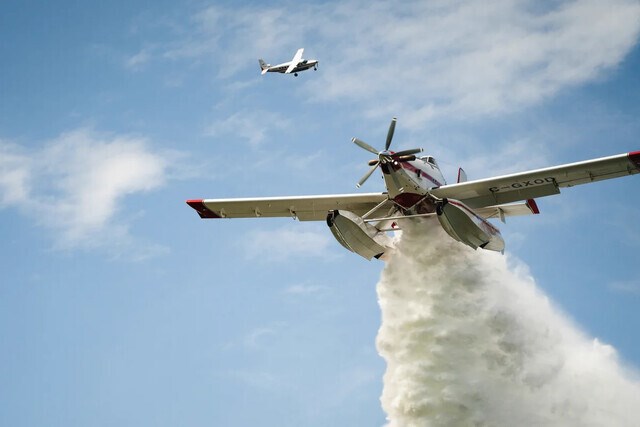The BC Wildfire Service says it's upgrading its aviation fleet and working to secure more lease agreements and contracts for planes and helicopters — including heavy helicopters with night-vision capability — ahead of this year’s fire season.
In a statement to Castanet, the BC Wildfire Service said it currently has access to 40 long-term aircraft located at about 14 bases, including airtanker and skimmer groups, light to heavy lift helicopters and two parattack jumpships.
Throughout the summer months, BCWS has airtanker contracts with Conair and Airspray, as well as dozens of helicopter contacts — meaning to more than 100 aircraft.
The 2024 provincial budget allocated $56 million to aviation preparedness and response, and BCWS said it is upgrading its fleet and pursuing more plane and helicopter leasing agreements.
“Our focus is on a diverse and modern set of aircraft suited for B.C.’s vast and challenging terrain,” the agency said.
Night vision tech will be used
The wildfire service said it is seeking longer-term casual contracts for a type of heavy helicopter with night-vision technology capability.
“This is the first year we are conducting longer-term hires for these helicopter types,” BCWS said.
The wildfire service said it has for several aviation staff ahead of fire season, with a goal to gradually train more people to build its capacity.
This summer, night vision technology will be used for reconnaissance, detection and mapping — missions which will help BCWS understand how the tech can be integrated into existing operations.
Night vision technology will also be trialled by aviation crews as they survey and support fire suppression activities during night operations.
In a news conference last week, Cliff Chapman, BCWS director of wildfire operations, said six additional staff were trained to be “night vision capable.”
“We’re going to continue to do research on what it looks like to do response activities, which is namely in the form of tanking operations where helicopters can tank at night, applying water on the fire,” Chapman said.
“But we’ve already made investments in being able to use night vision for detection, reconnaissance and situational awareness.”
Chapman said BCWS asks its helicopter contracting fleets to indicate if they have night vision flying capabilities so it can be integrated.
“We have taken some steps, and we continue to look at options for how we can integrate this technology into our 24-hour response to wildfires,” he said.
Super scoopers available if needed
This winter, BCWS from contractors about super scoopers — “large water-scooping fixed wing aircraft." Four CL-415 super scoopers to douse wildfires.
These specialized planes have also been loaned to B.C. from Alberta in past years.
According to BCWS, the ROI didn’t result in any new contracts — but the wildfire service will keep using the arrangements it has with other provinces and providers if the CL-415s are needed.
“They are available again to us this year,” Chapman said.
“We added to our air tanker fleet for this year in terms of the scooping aircraft that we utilize in B.C., and if needed — as I said, same with ground resources — when it comes to aviation fixed wing assets, we have relationships across North America and now the world where we can ask for additional aircraft to come in to support our fleet.”
The BCWS uses the Air Tractor AT-802F Fire Boss .
The wildfire service said its aviation contracts are awarded through a competitive process, but the BCWS can also bolster its fleet through mutual aid sharing agreements and other provisions — which includes the ability to ask for help from within Canada and internationally.
BCWS said its aircraft mainly supports the work of ground crews dispatched to a wildfire. Airtankers which drop fire retardant, like the Convair CF-580, Avro RJ-85 and Lockheed L-188 Electra, conduct about 560 missions in B.C. through the course of the average wildfire season.
Helicopters are used to cool hot spots by bucketing water, transporting personnel, and giving crews an aerial view of a wildfire.





